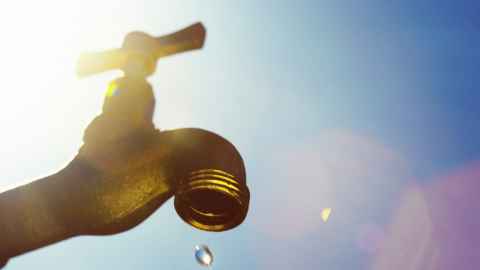Time for urgency on Auckland's water supply
10 June 2020
Opinion: In the face of water restrictions, Aucklanders might justifiably argue that Watercare and the council should have done more to avert what is a foreseeable water crisis, says David Grinlinton.

Localised shortages and occasional droughts aside, water is an abundant commodity in New Zealand. To some extent this explains the traditional complacency over water security in many parts of the country.
Forward planning has tended to follow the "just-in-time" approach with potable water supply just keeping ahead of normal demand, assuming normal rainfall patterns prevail.
As we now face increasing restrictions on water use, Aucklanders might justifiably argue that Watercare and the council should have done better to avert what is a foreseeable water crisis.
Despite years of warnings from organisations such as Niwa, and a fast-growing population set to exceed two million within the next eight years, there seems to have been little effective forward planning to ensure Auckland's water security, including a safety margin for drought years and the possible impacts of climate change.
It seems incomprehensible in these circumstances that water permit applications for increased take from the Waikato River have been stalled in a logjam of water consent applications stretching back seven years.
It seems incomprehensible in these circumstances that water permit applications for increased take from the Waikato River have been stalled in a logjam of water consent applications stretching back seven years.
The usual critics attribute this failure to the Resource Management Act (RMA), but this is disingenuous. There has been a lack of urgency on the part of decision-makers, and as already pointed out by others, there are mechanisms in the RMA to "fast-track" such applications. The Act provides that "proposals of national significance" may be "called in" by the Minister for the Environment to be decided more expeditiously by a Board of Inquiry, or by the Environment Court.
What qualifies as "nationally significant" is not prescribed in the Act, although relevant factors in determining whether a matter meets this level of importance include the Crown's "public health, welfare, security, or safety obligations or functions".
Given that and other guidance within the Act, it seems clear that ensuring a safe and secure water supply to almost a third of the country's population - incidentally also responsible for well over a third of the country's GDP - is without doubt a matter of national significance.
The call-in procedure has been used in the past for a number of other major infrastructural projects such as roading and energy developments. The time has surely come to use this process to expedite Auckland's water supply needs.
The "streamlining" provisions under the RMA, which allow a consent applicant to request that their application be determined directly by the Environment Court could also be used.
Tight time frames are set out that facilitate quicker processing of the application. Again - ensuring a secure water supply to the largest city in New Zealand is exactly the type of situation these provisions were designed for.
Both the call in and streamlining options would result in immediate prioritisation over the queue of other applications.
So far these comments apply to the proposals to increase supply from the Waikato River - a source of water that is far from pure and requires considerable filtering and treatment to be made safe for human consumption. Initially, the Waikato take was an emergency measure in response to Auckland's earlier water crisis in 1993-94.
It now comprises over one-third of Auckland's regular water supply. Due to its location Auckland enjoys a maritime climate, which in normal climatic cycles produces an abundance of rain, most of which runs off into the sea.
The better solution would be to increase the dam storage capacity in the Hunua and Waitakere ranges.
The better solution would be to increase the dam storage capacity in the Hunua and Waitakere ranges. Alternative solutions include the very expensive process of desalination, or the unpalatable recycling of wastewater which carries significant technical and cultural challenges.
But why would we go down that route when there is ample pure water available that simply requires expanded dam capacity? So for a long-term solution we should be starting the planning, design and consenting processes to increase the capture and storage capacity within Auckland's own region.
In terms of the current economic fallout from Covid-19, an essential infrastructural project such as this makes a lot of economic, strategic and social sense.
Other solutions could include more aggressive measures to increase efficiency and sustainability of water use, although Auckland's per capita water usage is already the second-lowest in New Zealand.
Relaxing rules around installing water tanks in industrial and domestic buildings for flushing toilets and other non-drinking uses, introducing stricter water conservation and re-use rules in new builds, and even subsidising water conservation measures in the same way that energy efficiency measures have been encouraged in recent years should all be part of a comprehensive and sustainable solution to the city's water woes.
Even if the rain gods smile upon us over the next few months, we still have a long-term problem that needs to be addressed with urgency.
David Grinlinton is a Professor of Law at the University of Auckland, focusing on environmental and natural resources law.
This article reflects the opinion of the author and not necessarily the views of the University of Auckland.
Used with permission from the New Zealand Herald, David Grinlinton: Time for urgency on Auckland's water supply, 9 June 2020.
Media queries
Miranda Playfair | Media Adviser
Mob: 021 063 8393
Email: m.playfair@auckland.ac.nz